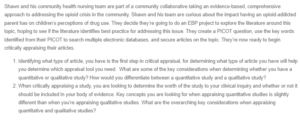Critical Appraisal for Articles – Quantitative and Qualitative Studies
Considerations when Determining whether you have a Quantitative or Qualitative Study
Quantitative research often entails collecting and analyzing numerical data, which is frequently done using statistical methods. They seek to quantify and assess relationships, factors, and results. Structured surveys, experiments, and data-driven analyses are common in quantitative research. Researchers use sample sizes, statistical tests, and numerical results to reach conclusions. On the other hand, qualitative studies are concerned with studying and comprehending the complexities of human experiences, behaviors, and perceptions (Bui Thanh Khoa et al., 2023). Non-numerical data sources such as interviews, observations, open-ended surveys, or textual analysis are used. Consistently, qualitative research aims to find themes, patterns, and deeper insights about a topic (Köhler et al., 2021). One should Look for clues in the article to differentiate between the two, such as the research methods used (e.g., surveys for quantitative, interviews for qualitative), the presentation of numerical data (quantitative) or detailed textual descriptions (qualitative), and whether the study aims to measure relationships or explore experiences and perceptions. Understanding these distinctions can aid in selecting the best critical appraisal method for your research.
Overarching Key Considerations when Appraising Quantitative and Qualitative Studies
When critically assessing quantitative studies, the overriding main factors focus on the study’s design, methodology, and statistical analysis. The clarity of the research topic, the suitability of the study design, the validity and reliability of data collection instruments, the sufficiency of the sample size and sampling procedures, the statistical analyses utilized, and the importance of the findings are all important considerations. It is also critical to assess potential sources of bias and the generalizability of results to the target group.
Subsequently, the primary focus of qualitative investigations switches to comprehending the breadth and depth of the research process. Reviewing the clarity and appropriateness of the research question or objectives, the rigor of data collection methods (e.g., interviews, observations), the transparency of data analysis techniques (e.g., thematic analysis, content analysis), data saturation (i.e., sufficient data to support findings), and the researcher’s reflexivity (acknowledging potential biases and subjectivity) are all important considerations. Evaluating qualitative findings’ credibility, transferability, dependability, and confirmability is critical in determining the study’s relevance to clinical research.
References
Bui Thanh Khoa, Bui Phu Hung, & Mohsen Hejsalem Brahmi. (2023). Qualitative research in social sciences: data collection, data analysis and report writing. 12(1/2), 187–209. https://doi.org/10.1504/ijpspm.2023.132247
Köhler, T., Smith, A., & Bhakoo, V. (2021). Templates in Qualitative Research Methods: Origins, Limitations, and New Directions. Organizational Research Methods, 25(2), 109442812110607. https://doi.org/10.1177/10944281211060710
ORDER A PLAGIARISM-FREE PAPER HERE
We’ll write everything from scratch
Question

Critical Appraisal for Articles
Shawn and his community health nursing team are part of a community collaborative taking an evidence-based, comprehensive approach to addressing the opioid crisis in the community. Shawn and his team are curious about the impact having an opioid-addicted parent has on children’s perceptions of drug use. They decide they’re going to do an EBP project to explore the literature around this topic, hoping to see if the literature identifies best practices for addressing this issue. They create a PICOT question, use the keywords identified from their PICOT to search multiple electronic databases, and secure articles on the topic. They’re now ready to begin critically appraising their articles.
- Identifying what type of article, you have is the first step in critical appraisal, for determining what type of article you have will help you determine which appraisal tool you need. What are some of the key considerations when determining whether you have a quantitative or qualitative study? How would you differentiate between a quantitative study and a qualitative study?
- When critically appraising a study, you are looking to determine the worth of the study to your clinical inquiry and whether or not it should be included in your body of evidence. Key concepts you are looking for when appraising quantitative studies is slightly different than when you’re appraising qualitative studies. What are the overarching key considerations when appraising quantitative and qualitative studies?

